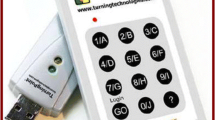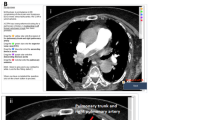Abstract
Pathology teaching, an intensively image loaded discipline, poses a significant challenge in its delivery. A lot of effort has been placed into sourcing teaching methods that could effectively enhance students’ understanding and knowledge retention in this discipline. We describe for the first time in the literature the use of an image-based quiz (IBQ) to deliver a neuropathology lecture. The participating medical students were randomised into either the study group (IBQ) or the control group (traditional lecture, TL). The students were asked to complete the pre- and post-multiple choice question (MCQ) test before and after attending either of the allocated interventions. In the IBQ group, the students were presented with image-based quizzes, and answers to the quizzes were projected in real-time on screen. The students in the TL group were given the usual, traditional lecture. A total of 75 third-year medical students participated in this study. The participants were recruited from third-year medical students representing two different academic years. There was no significant difference in the pre- and post-MCQ scores between the IBQ and TL groups. However, a significant improvement in the mean scores for the pre- and post-MCQ results in both the study (p = 0.001; 95% CI 0.572–1.954) and control (p < 0.001; 95% CI 0.561–1.763) groups was observed. We found that the IBQ was a simple, personalised, and cost-effective digitalised tool which our study suggests it to be as effective as the traditional lecture in the delivery of pathology knowledge in undergraduate medical students.
Similar content being viewed by others
Availability of Data and Materials
The anonymized datasets used and/or analysed during the current study are available from the corresponding author on reasonable request.
Abbreviations
- IBQ:
-
Image-based quiz
- TL:
-
Traditional lecture
- ART:
-
Audience response technology
References
Van den Tweel JG, Taylor CR. A brief history of pathology: preface to a forthcoming series that highlights milestones in the evolution of pathology as a discipline. Virchows Arch. 2010;457:3–10. https://doi.org/10.1007/s00428-010-0934-4.
Richardson D. Don’t dump the didactic lecture; fix it. Adv Physiol Educ. 2008;32:23–4. https://doi.org/10.1152/advan.00048.2007.
Kanter L. To be there or not to be there: is attendance really the question? Acad Med. 2012;87:679.
Liew SC, Sidhu J, Barua A. No more live lectures-quixotism or realism-? Association between learning preferences and attendances at live lectures. J Adv Med Med Res. 2017;20:1–10. https://doi.org/10.9734/BJMMR/2017/33051.
Lisk K, Agur AM, Woods NN. Exploring cognitive integration of basic science and its effect on diagnostic reasoning in novices. Perspect Med Educ. 2016;5:147–53.
Kędram J. What does it mean to be visually literate? Examination of visual literacy definitions in a context of higher education. J Vis Lit. 2018;37:67–84. https://doi.org/10.1080/1051144X.2018.1492234.
Sawarkar G, Kuchewar V, Desai P. Efficacy of quiz as a teaching and learning tool for first year. JHSE. 2015;2:92–5.
Samarakoon L, Fernando T, Rodrigo C, Rajapakse S. Learning styles and approaches to learning among medical undergraduates and postgraduates. BMC Med Educ. 2013;13:42. https://doi.org/10.1186/1472-6920-13-42.
Liew SC, Sidhu J, Barua A. The relationship between learning preferences (styles and approaches) and learning outcomes among pre-clinical undergraduate medical students. BMC Med Educ. 2015;15:44. https://doi.org/10.1186/s12909-015-0327-0.
Hightower JA, Boockfor FR, Blake CA, Millette CF. The standard medical microscopic anatomy course: histology circa 1998. Anat Rec. 1999;257:96–101.
Beck A, Wood C, Helms R, Arvizo C, Cherry BM, Ziats NP. Peer assisted learning in introductory histopathology improves learner scores and delivers learner satisfaction. Med Sci Educ. 2016;26:85–92.
Campos-Sánchez A, López-Núñez JA, Scionti G, Garzón I, González Andrades M, Alaminos M, Sola T. Developing an audio visual notebook as a self-learning tool in histology: perceptions of teachers and students. Anat Sci Educ. 2014;7:209–18.
Cogdell B, Torsney B, Stewart K, Smith RA. Technological and traditional drawing approaches encourage active engagement in histology classes for science undergraduates. Biosci Educ. 2012;19:115.
Rafi A, Rauf A, Anwar MI. Significance of actually drawing microscopic images and its impact on students’ understanding of histology. J Dow Univ Health Sci Karachi. 2017;11:77–81.
Carney RN, Levin JR. Pictorial illustrations still improve students’ learning from text. Educ Psychol Rev. 2002;14:5–26. https://doi.org/10.1023/A:1013176309260.
Paivio A. Mental representations: a dual coding approach. Oxford, UK: Oxford University Press; 1986.
Moreno R, Mayer RE. Cognitive principles of multimedia learning: the role of modality and contiguity. J Educ Psychol. 1999;91:358–68.
Hattie J, Timperley H. The power of feedback. Rev Educ Res. 2007;77:81–112. https://doi.org/10.3102/003465430298487.
Hattie J. Visible learning for teachers: maximizing impact on learning. Florence, GB: Routledge; 2014.
Nicol DJ, Macfarlane-Dick D. Formative assessment and self-regulated learning: a model and seven principles of good feedback practice. Stud High Educ. 2006;31:199–218. https://doi.org/10.1080/03075070600572090.
Devi K. Quiz as an innovative approach in teaching community medicine to medical students. Natl J Community Med. 2014;5:182–5.
Cain J, Black EP, Rohr J. An audience response system strategy to improve student motivation, attention, and feedback. Am J Pharm Educ. 2009;73:21.
Ernst H, Colthorpe K. The efficacy of interactive lecturing for students with diverse science backgrounds. Adv Physiol Educ. 2007;31:41–4.
Lymn J, Mostyn A. Audience response technology: engaging and empowering non-medical prescribing students in pharmacology learning. BMC Med Educ. 2010;10:73.
Doucet M, Vrins A, Harvey D. Effect of using an audience response system on learning environment, motivation, and long-term retention, during case-discussions in a large group of undergraduate veterinary clinical pharmacology students. Med Teach. 2009;31:e570–9.
Jones S, Henderson D, Sealover P. “Clickers” in the classroom. Teach Learn Nurs. 2009;4:2–5.
Porter AG, Tousman S. Evaluating the effect of interactive audience response systems on the perceived learning experience of nursing students. J Nurs Educ. 2010;49:523–7.
Paschal CB. Formative assessment in physiology teaching using a wireless classroom communication system. Adv Physiol Educ. 2002;26:299–308.
DeBourgh GA. Use of classroom ‘clickers’ to promote acquisition of reasoning skills. Nurs Educ Pract. 2008;8:76–87.
Pettit RK, McCoy L, Kinney M, Schwartz FN. Student perceptions of gamified audience response system interactions in large group lectures and via lecture capture technology. BMC Med Educ. 2015;15:92.
Looyestyn J, Kernot J, Boshoff K, Ryan J, Edney S, Maher C. Does gamification increase engagement with online programs? A systematic review. PLoS One. 2017;12:e0173403.
Acknowledgements
The authors would like to thank all the medical students that had participated in this study.
Author information
Authors and Affiliations
Contributions
SCL and VN conceived and conceptualised the study design. DHFA analysed the data. All authors interpreted the data and prepared, revised, and approved the manuscript.
Corresponding author
Ethics declarations
Ethics Approval and Consent to Participate
This study was approved by the Institutional Research Board (IRB) of Perdana University (PUIRBHR0155).
Consent for Publication
Non applicable.
Competing Interests
The authors declare no competing interests.
Additional information
Publisher's Note
Springer Nature remains neutral with regard to jurisdictional claims in published maps and institutional affiliations.
Rights and permissions
About this article
Cite this article
Liew, S.C., Naik, V. & Azim, D.H.F. Anonymous Audience Response Technology in Image-Based Quiz (IBQ) Neuropathology Lecture for Undergraduate Pre-clinical Medical Students: a Comparison with Traditional Lectures. Med.Sci.Educ. 31, 1889–1894 (2021). https://doi.org/10.1007/s40670-021-01433-5
Accepted:
Published:
Issue Date:
DOI: https://doi.org/10.1007/s40670-021-01433-5




